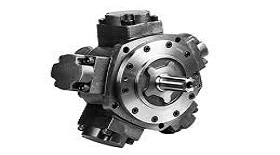Cycloid motor
In the late 1850s, the first low-speed, high-torque hydraulic motors were developed from a fixed-rotor part of the oil pump, which consisted of an inner gear ring and a matching gear or rotor. The inner gear ring can be fixed together with the shell, and the oil entering from the oil port drives the rotor around a central point. The slowly rotating rotor is driven by a spline shaft to produce a cycloidal hydraulic motor. After the invention of the first cycloid motor, over the course of several decades, another concept began to emerge. The motor has a roller in the internal gear. A motor with a roller provides higher start-up and running torque, which reduces friction and increases efficiency, and the output shaft produces stable output even at very low speeds. By changing the direction of input and output flow, the motor can be quickly reversed and produced equal value torque in both directions. Each series of motors has various displacement options to meet various speed and torque requirements.



